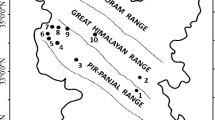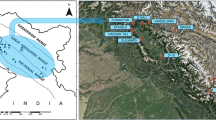Abstract
Maximum and minimum temperatures are used in avalanche forecasting models for snow avalanche hazard mitigation over Himalaya. The present work is a part of development of Hidden Markov Model (HMM) based avalanche forecasting system for Pir-Panjal and Great Himalayan mountain ranges of the Himalaya. In this work, HMMs have been developed for forecasting of maximum and minimum temperatures for Kanzalwan in Pir-Panjal range and Drass in Great Himalayan range with a lead time of two days. The HMMs have been developed using meteorological variables collected from these stations during the past 20 winters from 1992 to 2012. The meteorological variables have been used to define observations and states of the models and to compute model parameters (initial state, state transition and observation probabilities). The model parameters have been used in the Forward and the Viterbi algorithms to generate temperature forecasts. To improve the model forecasts, the model parameters have been optimised using Baum–Welch algorithm. The models have been compared with persistence forecast by root mean square errors (RMSE) analysis using independent data of two winters (2012–13, 2013–14). The HMM for maximum temperature has shown a 4–12% and 17–19% improvement in the forecast over persistence forecast, for day-1 and day-2, respectively. For minimum temperature, it has shown 6–38% and 5–12% improvement for day-1 and day-2, respectively.




Similar content being viewed by others
References
Attri S D, Pandya A B and Dubey D P 1995 Forecasting of minimum temperature over Gangtok; Mausam 46 63–68.
Baum L E, Petrie T, Soules G and Weiss N 1970 A maximum technique occurring in the statistical analysis of probabilistic functions of Markov chains; Ann. Math. Stat. 41 (1) 164–171.
Bicego M, Castellani U and Murino V 2003. Using Hidden Markov Models and wavelets for face recognition; Proc. 12th Int. Conf. Imag. Analysis Process.
Bhusari V and Patil S 2011 Application of Hidden Markov Model in credit card fraud detection; Int. J. Distrib. Parall. Syst. 2 (6) 203–211.
Bolch T, Kulkarni A, Kääb A, Huggel C, Paul F, Cogley J G, Frey H, Kargel J S, Fujita K, Scheel M, Bajracharya S and Stoffel M 2012 The state and fate of Himalayan glaciers; Science 336 310–314.
Chrantorois T and Liakatas A 1990 Study of minimum temperatures employing Markov chains; Mausam 41 69–74.
Dimri A P, Mohanty U C and Ravi N 2002 Statistical model based forecast of minimum and maximum temperature at Manali; Curr. Sci. 82 997–1003.
Dimri A P, Mohanty U C and Rathore L. 2005 Minimum temperature forecast at Manali, India; Curr. Sci. 88 (4) 927–934.
Gales M and Young S 2007 Application of Hidden Markov Model in speech recognition; Found. Trends Sign. Process. 1 (3) 195–304.
Hughes J P and Guttorp P 1994 Incorporating spatial dependence and atmospheric data in a model of precipitation; J. Appl. Meteorol. 33 1503–1515.
Joshi J C and Srivastava S 2014 A Hidden Markov Model for avalanche forecasting on Chowkibal–Tangdhar road axis in Indian Himalayas; J. Earth Syst. Sci. 123 (8) 1771–1781.
Maini P, Kumar A, Singh S V and Rathore L S 2002 Statistical interpretation of NWP products in India; Meteorol. Appl. 9 (1) 21–31.
Mohan V, Jargle N K and Kulkarni P D 1989 Numerical prediction of daily maximum temperature over Ozar; Mausam 40 227–228.
Mohanty U C, Ravi N, Madan O P and Paliwal R K 1997 Forecasting minimum temperature during winter and maximum temperature during summer at Delhi; Meteorol. Appl. 4 (1) 37–48.
Kumar A and Maini P 1996 Statistical interpretation of general circulation model: A prospect for automation of medium range local weather forecast in India; Mausam 47 (3) 229–236.
Rabiner L R 1989 A tutorial on Hidden Markov Model and selected applications in speech recognition; Proceedings of IEEE 73 (2).
Raj Y E A 1989 Prediction of winter minimum temperature at Pune by analogue and regression method; Mausam 40 175–180.
Raj Y E A 1998 On forecasting daily minimum temperature at Madras; Mausam 49 95–102.
Robertson A W, Kirshner S and Smyth P 2004 Downscaling of daily rainfall occurrence over Northeast Brazil using a hidden Markov model; J. Climate 17 (22) 4407–4424.
Sanjeeva Rao P, Saseendran S A, Rathore L S and Bahadur 1996 Medium range weather forecasts in India during monsoon-1994; J. Meteorol. Appl. 3 317–324.
Singh D, Ganju A and Singh A 2005 Weather prediction using nearest-neighbor model; Curr. Sci. 88 (8) 1283–1289.
Tanguay D O 1995 Hidden Markov Model for gesture recognition; ME Thesis, Massachusetts Institute of Technology.
Vashisht R C and Pareek R S 1991 Forecasting of minimum temperature at Jaipur and south Rajasthan; Mausam 42 113–116.
Viterbi A J 1976 Error bounds for convolutional codes and an asymptotically optimum decoding algorithm; IEEE Trans. Info. Theory 13 (2) 260–269.
Woodcock F 1984 Australian experimental model output statistics forecasts of daily maximum and minimum temperature; Mon. Wea. Rev. 112 2112–2121.
Xuan T 2004. Autoregressive Hidden Markov Model with application in an El-Nino study; MS Thesis, University of Saskatchewan Saskatoon.
Zhang Y 2004. Prediction of financial time series with Hidden Markov Models; MS Thesis, Simon Fraser University.
Zucchini W and Guttorp P 1991 A Hidden Markov Model for space–time precipitation; Water Resour. Res. 27 1917–1923.
Acknowledgements
The authors acknowledge all the reviewers of this paper for the valuable suggestions and positive comments. Director, SASE is duly acknowledged for providing support and encouragement. Field data collection teams of Snow and Avalanche Study Establishment are also acknowledged for collecting data in adverse climatic conditions of the Himalaya during winter.
Author information
Authors and Affiliations
Corresponding author
Additional information
Corresponding editor: A K Sahai
Rights and permissions
About this article
Cite this article
JOSHI, J.C., KUMAR, T., SRIVASTAVA, S. et al. Optimisation of Hidden Markov Model using Baum–Welch algorithm for prediction of maximum and minimum temperature over Indian Himalaya. J Earth Syst Sci 126, 3 (2017). https://doi.org/10.1007/s12040-016-0780-0
Received:
Revised:
Accepted:
Published:
DOI: https://doi.org/10.1007/s12040-016-0780-0




